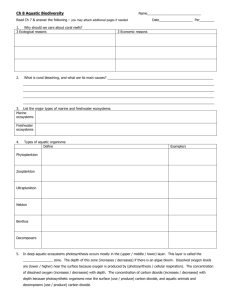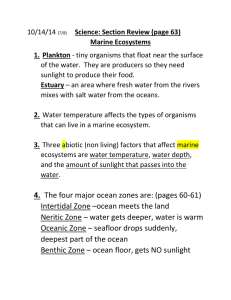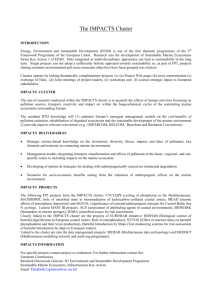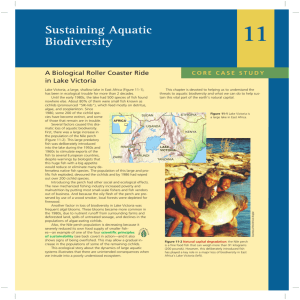Unit 2 Vocab & Questions
advertisement
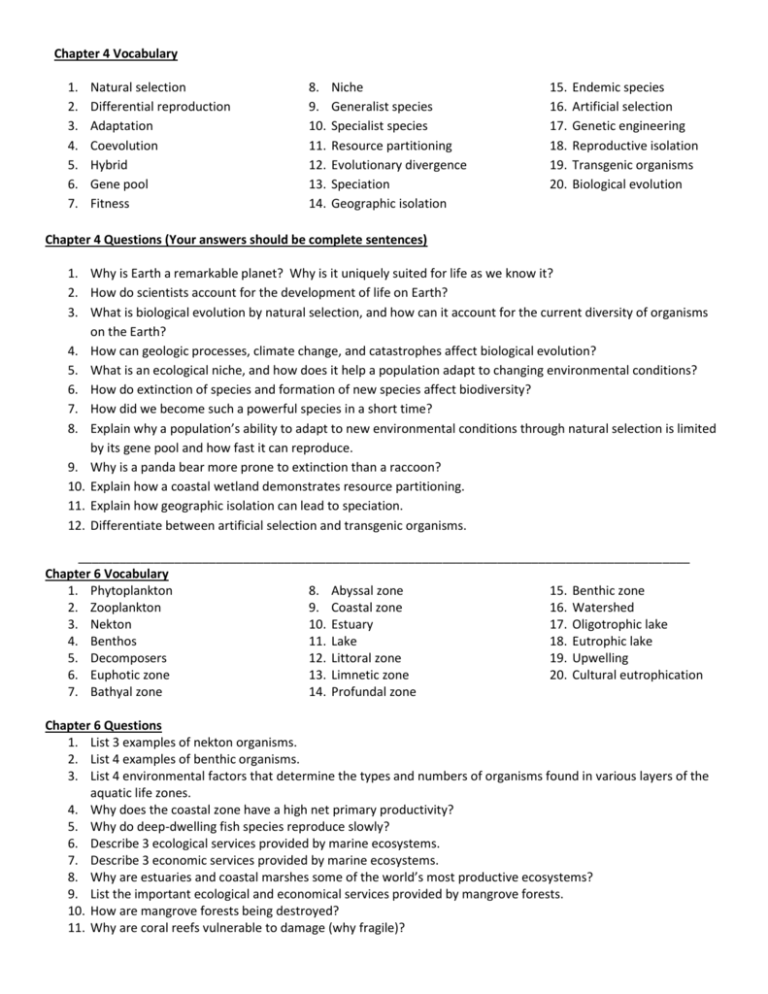
Chapter 4 Vocabulary 1. 2. 3. 4. 5. 6. 7. Natural selection Differential reproduction Adaptation Coevolution Hybrid Gene pool Fitness 8. 9. 10. 11. 12. 13. 14. Niche Generalist species Specialist species Resource partitioning Evolutionary divergence Speciation Geographic isolation 15. 16. 17. 18. 19. 20. Endemic species Artificial selection Genetic engineering Reproductive isolation Transgenic organisms Biological evolution Chapter 4 Questions (Your answers should be complete sentences) 1. Why is Earth a remarkable planet? Why is it uniquely suited for life as we know it? 2. How do scientists account for the development of life on Earth? 3. What is biological evolution by natural selection, and how can it account for the current diversity of organisms on the Earth? 4. How can geologic processes, climate change, and catastrophes affect biological evolution? 5. What is an ecological niche, and how does it help a population adapt to changing environmental conditions? 6. How do extinction of species and formation of new species affect biodiversity? 7. How did we become such a powerful species in a short time? 8. Explain why a population’s ability to adapt to new environmental conditions through natural selection is limited by its gene pool and how fast it can reproduce. 9. Why is a panda bear more prone to extinction than a raccoon? 10. Explain how a coastal wetland demonstrates resource partitioning. 11. Explain how geographic isolation can lead to speciation. 12. Differentiate between artificial selection and transgenic organisms. _________________________________________________________________________________________ Chapter 6 Vocabulary 1. Phytoplankton 8. Abyssal zone 15. Benthic zone 2. Zooplankton 9. Coastal zone 16. Watershed 3. Nekton 10. Estuary 17. Oligotrophic lake 4. Benthos 11. Lake 18. Eutrophic lake 5. Decomposers 12. Littoral zone 19. Upwelling 6. Euphotic zone 13. Limnetic zone 20. Cultural eutrophication 7. Bathyal zone 14. Profundal zone Chapter 6 Questions 1. List 3 examples of nekton organisms. 2. List 4 examples of benthic organisms. 3. List 4 environmental factors that determine the types and numbers of organisms found in various layers of the aquatic life zones. 4. Why does the coastal zone have a high net primary productivity? 5. Why do deep-dwelling fish species reproduce slowly? 6. Describe 3 ecological services provided by marine ecosystems. 7. Describe 3 economic services provided by marine ecosystems. 8. Why are estuaries and coastal marshes some of the world’s most productive ecosystems? 9. List the important ecological and economical services provided by mangrove forests. 10. How are mangrove forests being destroyed? 11. Why are coral reefs vulnerable to damage (why fragile)? 12. 13. 14. 15. 16. 17. 18. 19. 20. 21. 22. 23. 24. 25. 26. 27. 28. 29. 30. 31. 32. 33. 34. Why does the ocean floor contain more nutrients than the euphotic zone? What is marine snow? What is upwelling in the ocean? Why are upwellings important? As we move from the equator to the poles we find more ocean life and an abundance of producers. We find more producers in the cold, arctic waters than the warmer, tropical waters. Explain why? List 4 major threats to coral reefs. Describe 2 major human impacts on the world’s marine ecosystems. Describe 4 ecological services provided by freshwater ecosystems. Describe 3 economic services provided by freshwater ecosystems. Describe 3 ways lakes are formed naturally. Describe the 4 distinct zones of deep lakes: littoral, limnetic, profundal, and benthic. Why is the littoral zone the most productive zone? What is the significance of an overturn in a deep lake? Differentiate between an oligotrophic lake and an eutrophic lake. What is cultural eutrophication? Define surface waters and watershed. Why are streams in the source zone not very productive? Why are coastal deltas and wetlands and inland floodplains important parts of the Earth’s natural capital? Why must we focus on the watershed to protect a stream or a river? What is the difference between a marsh and a swamp? What is a seasonal wetland? Describe 2 ecological services provided by inland wetlands. Describe 2 economic services provided by inland wetlands. How do the following human activities affect freshwater ecosystems: a. Dams, diversions, and canals b. Flood control levels and dikes c. Cities and farmlands 35. What is happening to the inland wetlands of the U.S.? 36. List 4 factors in your lifestyle that contribute directly or indirectly to the destruction and degradation of coastal and inland wetlands. 37. Why are some aquatic animals, especially marine mammals such as whales, extremely large compared with terrestrial animals? ____________________________________________________________________________________________ Ch. 12 Vocabulary 1. 2. 3. 4. 5. 6. 7. 8. 9. Nile perch Asian swamp eel Purple loosestrife Bycatch Trawler fishing Purse-seine fishing Longlining Driftnet fishing Turtle exclusion device (TED) 10. Commercial extinction 11. Exclusive economic zone (EEZ) 12. Marine protected areas 13. Marine reserves 14. Integrated coastal management 15. Maximum sustainable yield (MSY) 16. Optimum sustainable yield (OSY) 17. Precautionary principle 18. Mitigation banking 19. Comprehensive Everglades Restoration Plan 20. Zebra mussel 21. Sea lamprey 22. Quagga mussel 23. National Wild and Scenic Rivers Act Chapter 12 Questions 1. What are the 4 factors which caused the dramatic loss of aquatic biodiversity in Lake Victoria? 2. What were the social and economic effects of introducing the nile perch into Lake Victoria? 3. 4. 5. 6. 7. 8. Why is the Asian swamp eel a successful invader species in the waters of Florida? Be specific. Explain how purple loosestrife is degrading our wetlands. How is the U.S. fighting against the purple loosestrife? Explain HIPPO as it relates to aquatic biodiversity. Why are industrial fishing fleets so successful in harvesting marine fish? Describe the following: a. Trawler fishing b. Purse-seine fishing c. Longlining d. Drift-net fishing 9. 10. 11. 12. 13. 14. 15. 16. 17. 18. 19. Why is it difficult to protect aquatic biodiversity? List reasons why marine sea turtles are threatened or endangered. List reasons why the Florida manatee is threatened. What is a TED? What is its importance? What is the exclusive economic zone? What is its purpose? Why has the MSY concept not worked well to sustainably manage marine fisheries? What are the options? How are scientists using the precautionary principle for managing marine fisheries? What is mitigation banking in relation to wetlands? What is a wetland restoration bank? What is its purpose? What are the goals of the Comprehensive Everglades Restoration Plan? Identify 8 ways we can manage and sustain freshwater fisheries.

